Social Media Marketing Survey 2016
August 9, 2016
![]() At the beginning of 2016, marketing professionals made a variety of predictions (link is external) about the future of digital marketing. Some of the most notable forecasts pointed to the increasing importance of data collection, video advertising, virtual reality, and live streaming.
At the beginning of 2016, marketing professionals made a variety of predictions (link is external) about the future of digital marketing. Some of the most notable forecasts pointed to the increasing importance of data collection, video advertising, virtual reality, and live streaming.
But, the term digital marketing is comprehensive. It includes content creation, social media, search engine optimization (SEO), online advertising, email, and mobile app and website use.
Throughout the past four years, social media has dominated the marketing industry’s news cycle – from Instagram’s integration with Facebook, to countless algorithm changes across multiple platforms, to Microsoft’s acquisition of LinkedIn.
What do these changes mean for businesses that view social media as a key part of their marketing strategy?
Key Findings
- Social media is most important for digital marketing success, say 80% of enterprises
- YouTube is one of the most popular social media channels for 61% of enterprises
- Video outperforms images, offers and promotions, and articles on social media
- Facebook yields the best results for 62% of enterprises
- B2B companies more likely to choose LinkedIn over YouTube but don’t shy away from Instagram either
Recommendations
- Pair social media with other digital marketing efforts, like SEO and email marketing, if your end goal is to generate revenue and leads.
- Embrace creativity in the social media strategy development process. For example, business-to-business (B2B) companies do not need to limit themselves to using Facebook and LinkedIn only.
- Select social media channels based on the audience you want to reach, the amount of users on a platform, and the type of content you plan to share.
- Consider incorporating video into your social media plan in order to appeal to users’ interest in interactive and live content.
- Dedicate additional human and financial resources for social media. Consider working with a social media marketing agency or consultant.
- Take advantage of social media’s benefits by investing in paid social advertising, regularly interacting with customers, and using targeting features to reach appropriate audiences.
DATA INSIGHTS
We surveyed 304 social media marketers at medium and large enterprises in the US to determine how they see the role of social media in the broader context of digital marketing. We define enterprises as medium- to large-sized organizations with more than 100 employees. In this study, 62% of respondents have over 500 employees.
Importance of Social Media in Digital Marketing
With 81 percent of consumers (link is external) in the habit of conducting research online before making a purchasing decision, building an online presence is imperative. Businesses can do this through SEO, email, content, advertising, and social media.
Which digital marketing tactic do they prioritize? Almost 80 percent of enterprises say social media is more important for business success than other digital marketing strategies.
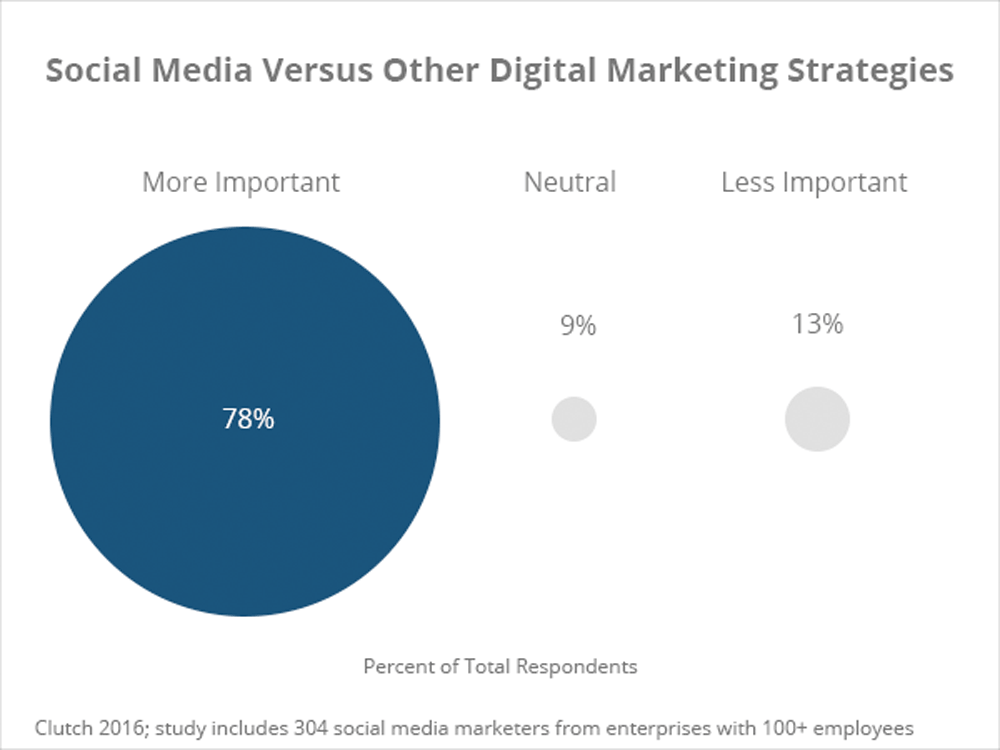
The overwhelming support for social media shows that large businesses value customer engagement.
However, some digital marketing professionals caution businesses against putting too much faith in social media as a revenue- or lead-building strategy. Other tactics, like SEO and email, are better options.
Most Popular Social Media Channels
Selecting the social media platforms that are best for your business should be a customized process (link is external). The choice depends on the audience you want to reach, the amount of users on a particular channel, and the type of content you have to share.
For enterprises, Facebook, Twitter, and YouTube are most popular, closely followed by LinkedIn and Instagram.
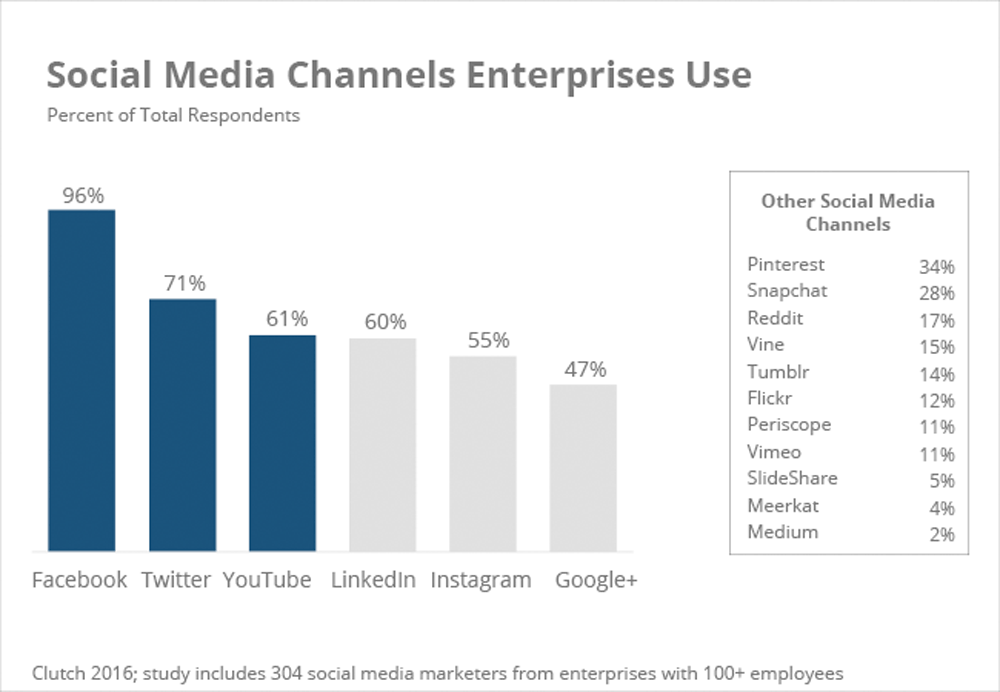
With Facebook’s nearly two billion monthly active users (link is external), Instagram’s 400 million, and Twitter’s 310 million, the social channels enterprises use the most make sense. A business that wants to build its brand, distribute content widely, and increase its customer base, needs to be on the platforms that have the most users.
But, what about YouTube?
Although some marketing professionals expressed surprise that enterprises prioritize YouTube over other big-name social channels, like LinkedIn and Instagram, others point out that YouTube is a unique medium for businesses seeking to improve SEO and enhance their content strategy.
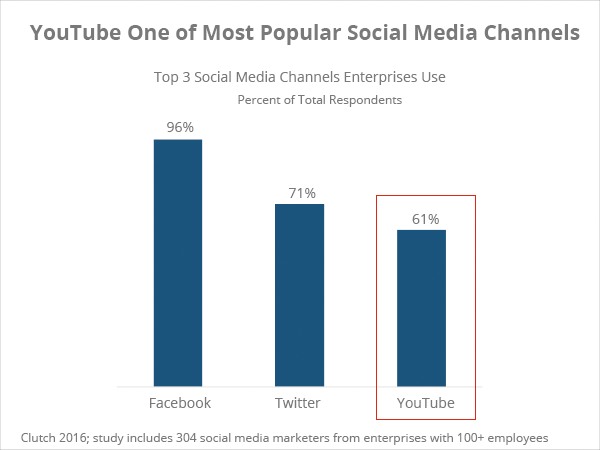
YouTube’s prominence highlights businesses’ appreciation of video as a multi-functional content medium. Video engages, entertains, informs, and educates. It appeals to our short attention spans and our habit of consuming information on mobile devices. It’s digestible.
In fact, enterprises point to video, images, and offers and promotions as the content that performs best for their company.
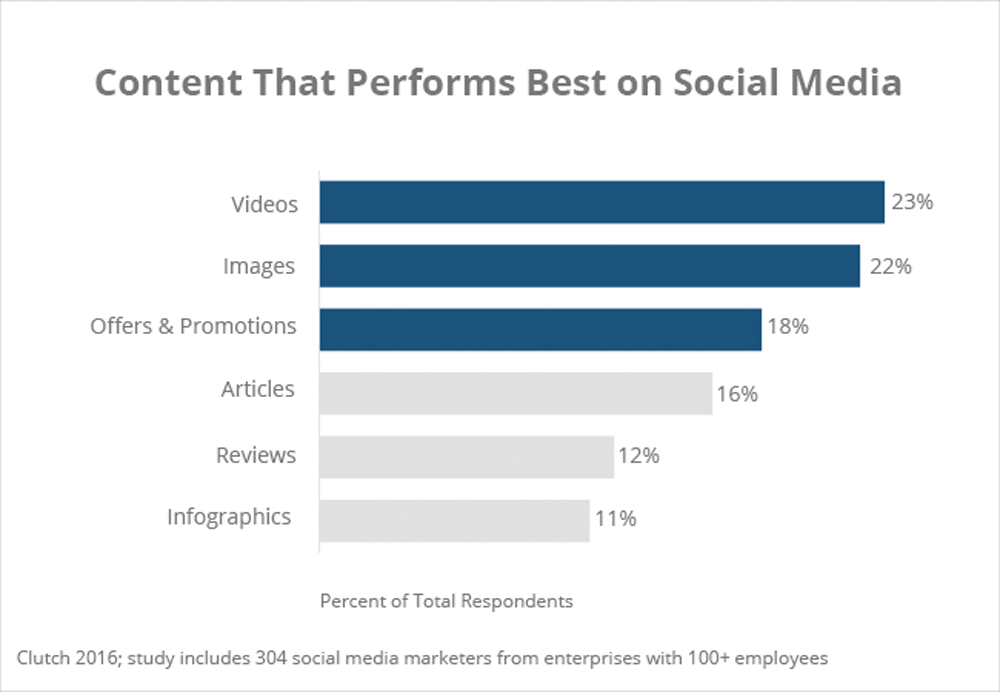
Facebook, Twitter, Snapchat, and Instagram recognize the importance of video as well.
First, in 2013, Facebook tested automatically playing videos in the News Feed. Then at the end of 2015, it rolled out Facebook Live, a hub for streaming videos in real-time. Live videos are more likely to show up higher in the News Feed (link is external).
B2B Versus B2C: Navigating the Social Media Platform Selection Process
Business-to-business (B2B) and business-to-consumer (B2C) companies prioritize Facebook and Twitter. But, B2Cs rank YouTube third, higher than LinkedIn, while B2Bs rank it fourth, just behind LinkedIn.
There’s no one-size-fits all strategy for social media. It depends on your goals, who you want to reach, and the type of services you offer.
This holds true when choosing social media platforms for B2B and B2C companies. However, it’s important not to restrict B2B companies to LinkedIn. Certain features of B2C-associated social platforms, like Instagram and Pinterest, can benefit B2B companies as well.
Overall, regardless of business type, being on multiple channels offers more opportunities for a business to reach current and potential customers.
Social Media Channels That Yield The Best Results
Facebook holds a clear lead as the most effective social media channel, according to 62 percent of enterprises. LinkedIn (14%) and Twitter (7%) follow. And, the same ranking holds true when looking at B2C and B2B companies separately.

To understand the features that make a social media platform effective, consider a business’ goals.
Enterprises use social media to increase website traffic, enhance their brand image, and target their audience and influencers. At the same time, they struggle to develop a robust social media strategy, track results, and keep up with platform changes.
The channels that yield the best results have features that make it easier to benefit from social media use and overcome the associated challenges.
ACTIONABLE ADVICE
How to Overcome Social Media Marketing Challenges
The top three challenges of social media marketing are developing a comprehensive social media strategy, tracking results, and keeping up with platform changes.
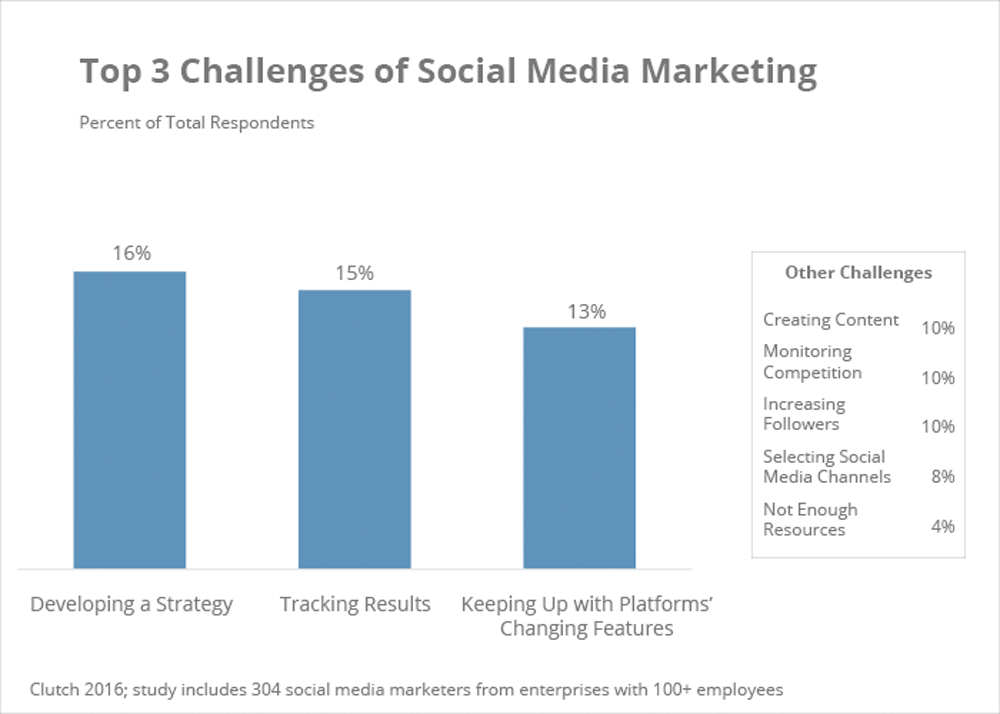
What steps can you take to address these difficulties?
1. Develop a Content Creation and Distribution Schedule
Content plays a significant role in social media strategy. In fact, it makes up more than half of the strategy – roughly 60 to 65 percent, according to Marty McDonald of Bad Rhino, Inc. However, 16 percent of social media marketers say developing a strategy is their primary challenge.
When it comes to content strategy, enterprises are most likely to share original content – produced by your company – with some curated content – found in other relevant sources – in the mix.
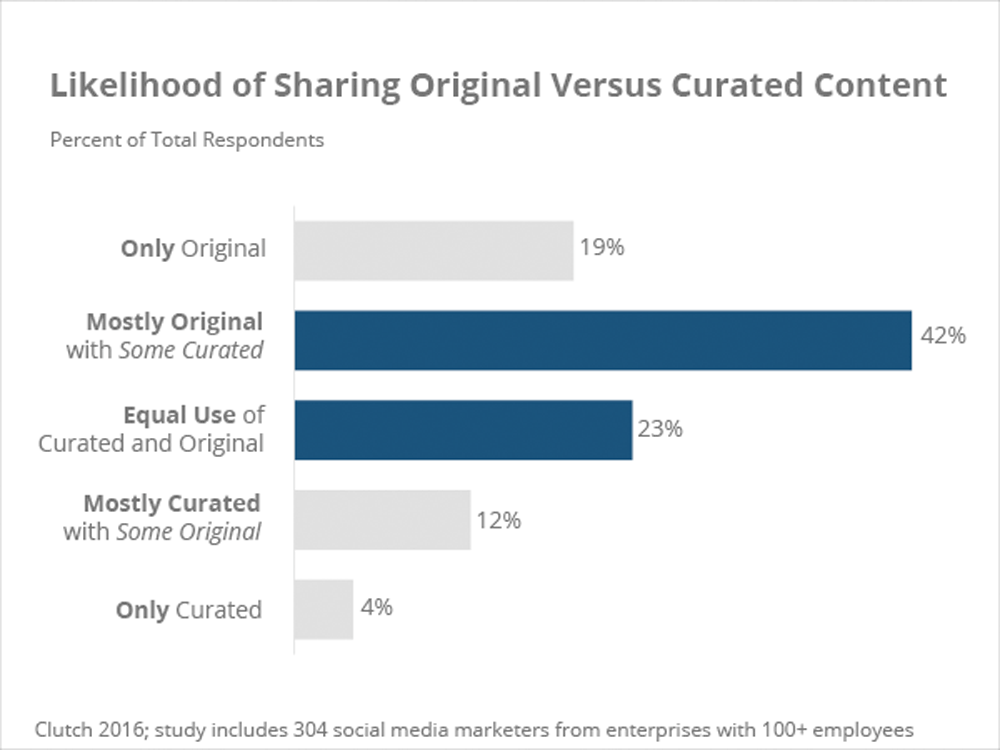
But, the ability to share content produced by your company on a regular basis depends on the availability of human and financial resources, which 11 percent of social media marketers lack.
Creating a calendar that outlines what types of content you share, when you share them, and on which channels makes it easier to determine the content that performs best.
2. Set Aside Human and Financial Resources For Social Media
Businesses that do not have a dedicated, in-house marketing team to manages their social media accounts, may find it difficult to track results and stay ahead of the channels’ many algorithm and platform updates. One trap is focusing on tactics instead of considering how these actions affect the return on investment (ROI). 15 percent of social media marketers say tracking results is challenging.
3. Consider Hiring a Social Media Marketing Agency
Most enterprises (65%) do not work with a social media marketing agency to address their social media challenges.
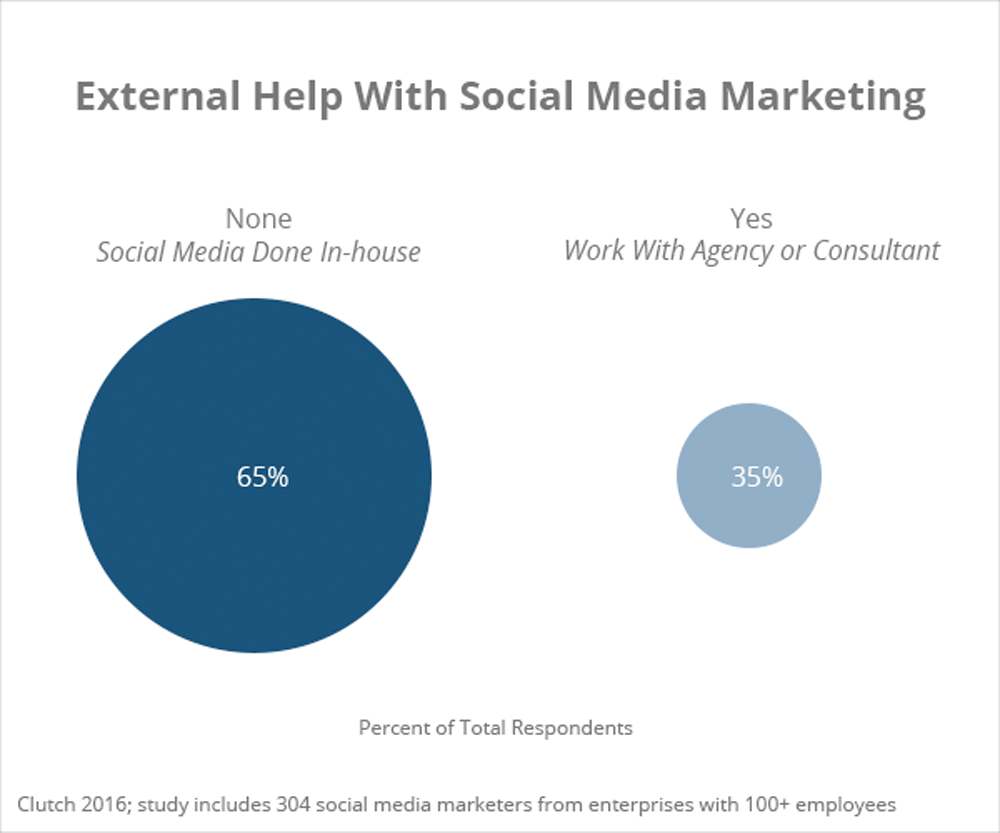
However, a full-service social media agency or consultant can craft a tailored plan that addresses a business’ social media challenges. Agencies are particularly helpful when it comes to strategy development and reputation management.
How to Take Full Advantage of Social Media’s Benefits
The top three benefits of social media marketing are increased website traffic, enhanced brand image, and improved audience targeting capabilities. But, attaining these benefits requires developing and executing a strategic game plan.
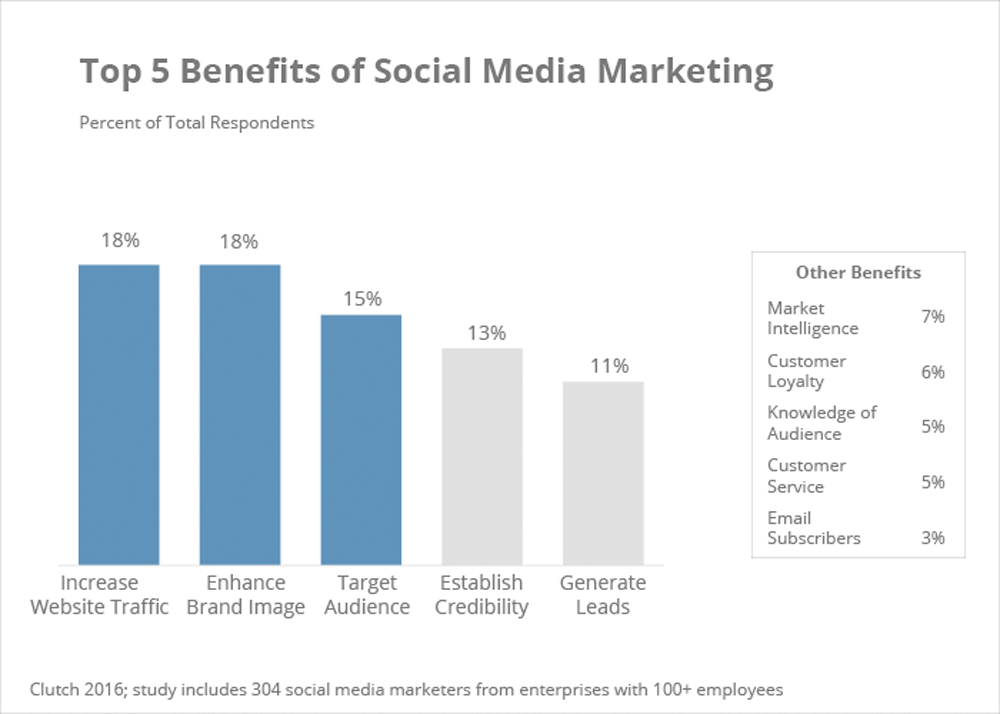
Consider three important aspects of a social media strategy:
1. Invest In Paid Social Advertising
Social media platforms’ advertising capabilities can help a business increase their website traffic by encouraging click-throughs on content.
Approaches to paid social advertising differ across channels (link is external), from sponsoring stories on Facebook, to promoting Tweets on Twitter, to buying ads on YouTube, to sponsoring updates on LinkedIn.
2. Monitor Your Social Channels and Respond to Customers
Social media is the ideal outlet for interacting with customers. Take the time to respond to complaints, answer questions, and guide your audience to useful resources.
Consider these tips for interacting with customers on social media (link is external):
- Start a conversation by responding to all feedback. Social media is a key tool for understanding what your audience wants, what confuses them, and what they appreciate.
- Address complaints as soon as possible.
- Lay out a plan for responding to customers. It may include linking to an FAQs page, offering additional contact information, or explaining the solution over the social channel.
3. Learn How To Use Targeting Features
Targeting allows a company to reach a specific portion of its audience based on different characteristics.
For example, on Instagram and Facebook, a company can choose who sees an ad based on demographics, interests, and user actions onsite. More advanced targeting options include Lookalike Audience, or group of people that is similar to your customers, and Custom Audience, a pre-determined list of people selected from current customers.
ABOUT THE SURVEY
The survey included 304 respondents who are either ‘extremely involved’ or ‘somewhat involved’ in their company’s social media marketing. 80 percent were manager level or higher.
Respondents worked at companies with more than 100 employees, with 62 percent representing companies with over 500 employees. 71 percent worked at B2C companies, while 29 percent worked at B2B companies.
The data was collected throughout April 2016.






























